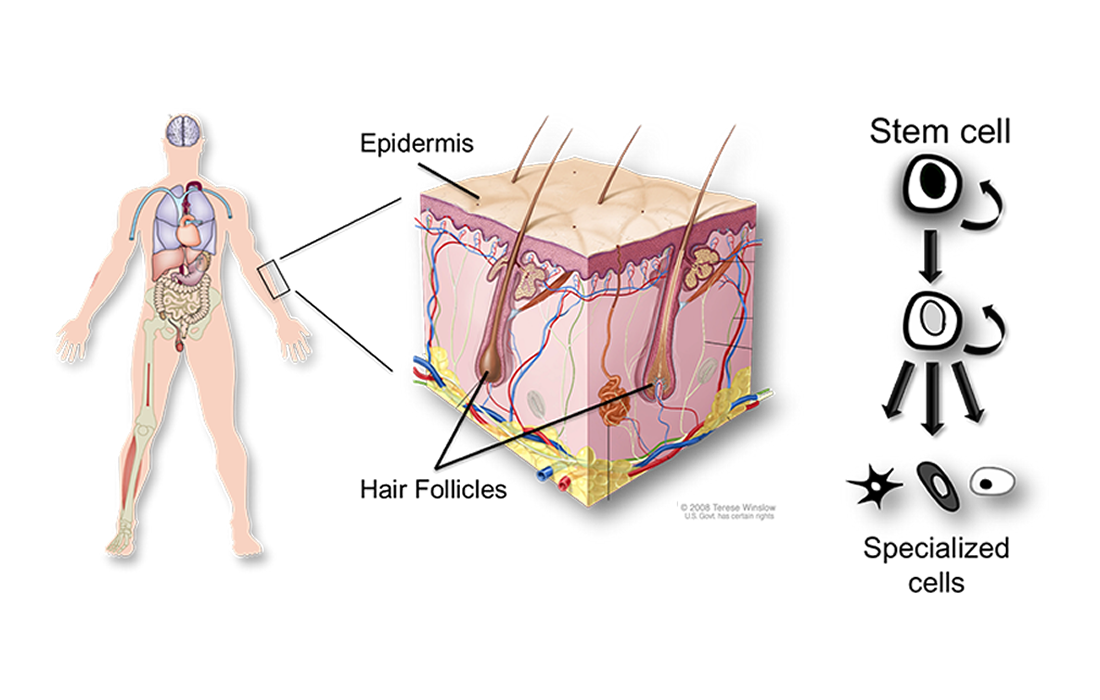Anti-Aging
Stem cells in the human skin
The skin is a complicated organ composed of various kinds of cells and has three layers, the epidermis, dermis and subcutaneous adipose tissue. The skin covers the whole body as a barrier and plays important roles in protection from environmental factors including physical and chemical stimuli as well as ultraviolet rays.
Recent studies have revealed that the capacity of maintaining skin homeostasis is greatly attributed to stem cells. There are stem cells in the epidermis, dermis, subcutaneous adipose tissue and the bulge region of hair follicles, and stem cells in each tissue duplicate and differentiate to supply new cells that function to maintain or repair damaged or injured tissues.
In contrast, as age increases, the skin changes; for example, reduced function of each tissue, increased susceptibility to external stimuli and decreased capacity to maintain homeostasis are observed with age. These changes may be attributed to senescent cells accumulated in aged skin. senescent cells secrete senescence-associated secretory phenotype (SASP) factors, such as proinflammatory cytokines, chemokines and matrix metalloproteinases (MMPs), and damage surrounding tissues, leading to a reduced function of the whole tissue.
When the damaging effect of SASP factors on tissues surpasses the capacity of tissue regeneration, aging features and functional reductions of tissues may appear.
Mika Kawagishi-Hotta, et al investigated SASP factors and stem cells in the skin. They observed an increase of Gremlin 2 (GREM2) expression in senescence-induced keratinocytes and fibroblasts, in addition to an increase of major SASP factors in the skin.
They also showed that GREM2 expression was higher in the skin from the elderly than from the young and that the individual differences in GREM2 expression varied more largely in the elderly and that GREM2 suppresses the differentiation of human adipose-derived stromal/stem cells.
Their findings suggest that GREM2 downregulates the differentiation of epidermal and dermal stem cells into mature functional cells. Additionally, GREM2 suppresses the osteoblast differentiation of bone marrow-derived mesenchymal stem cells. Their results also showed that GREM2 functions in suppressing the differentiation of skin stem cells and that when GREM2 expression is increased by aging, the differentiation of skin stem cells may be downregulated and immaturely differentiated cells, which become a part of tissue, may cause a reduction in the tissue function.
Recently, removal of senescent cells has been reported to prevent or ameliorate age related diseases or dysfunction of tissues. In a mouse model, removal of skin senescent cells restored the thickness of subcutaneous adipose tissue, which suggests that SASP factors secreted from senescent cells accumulating with age may have a bad influence on the homeostasis of the skin.
The study suggests that regulating the expression of GREM2 may prevent or ameliorate age-related dysfunction of the skin. Further investigation on the functional mechanism of this factor in the skin will elucidate how it is involved in the regeneration of the skin.
Source: Mika Kawagishi-Hotta, et al. Gremlin 2 suppresses differentiation of stem/progenitor cells in the human skin. Regenerative Therapy, Volume 18, 2021, Pages 191-201.
Source link: https://www.sciencedirect.com/science/article/pii/S2352320421000523

